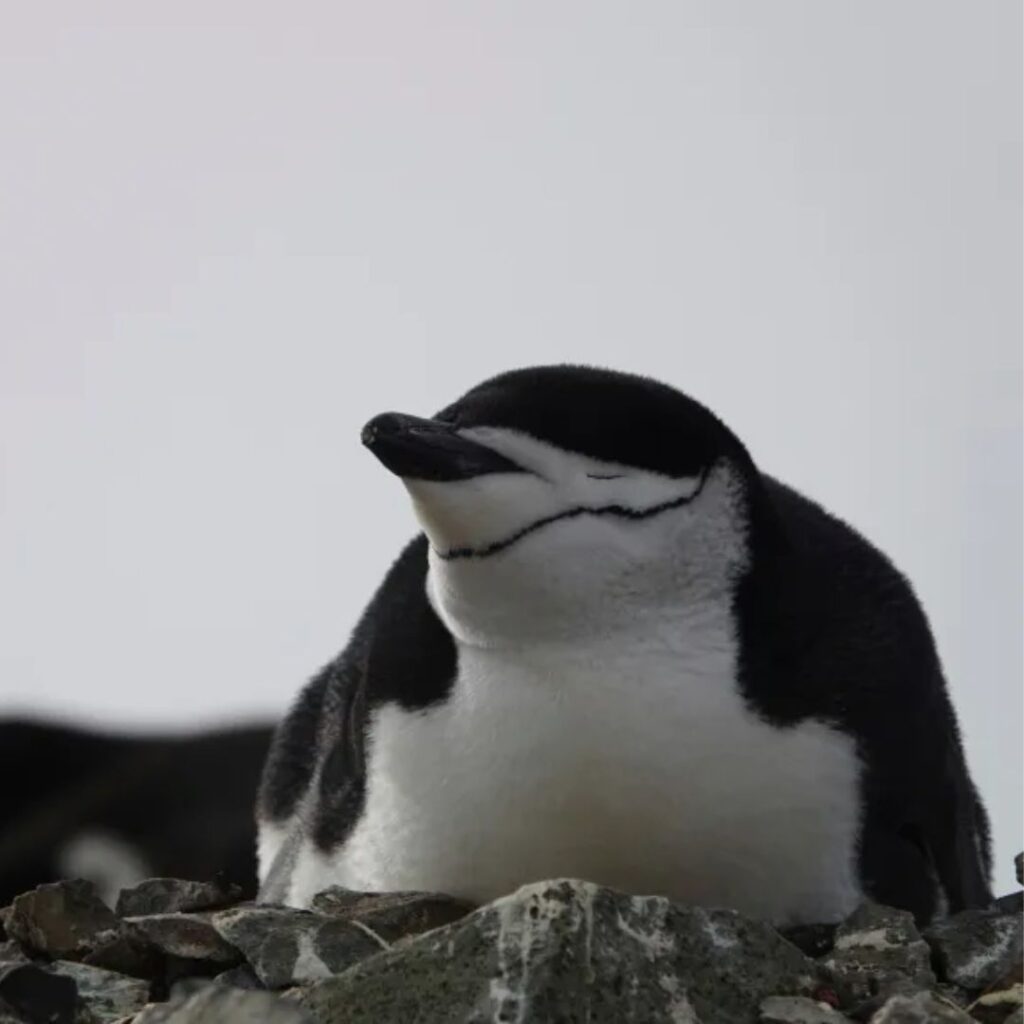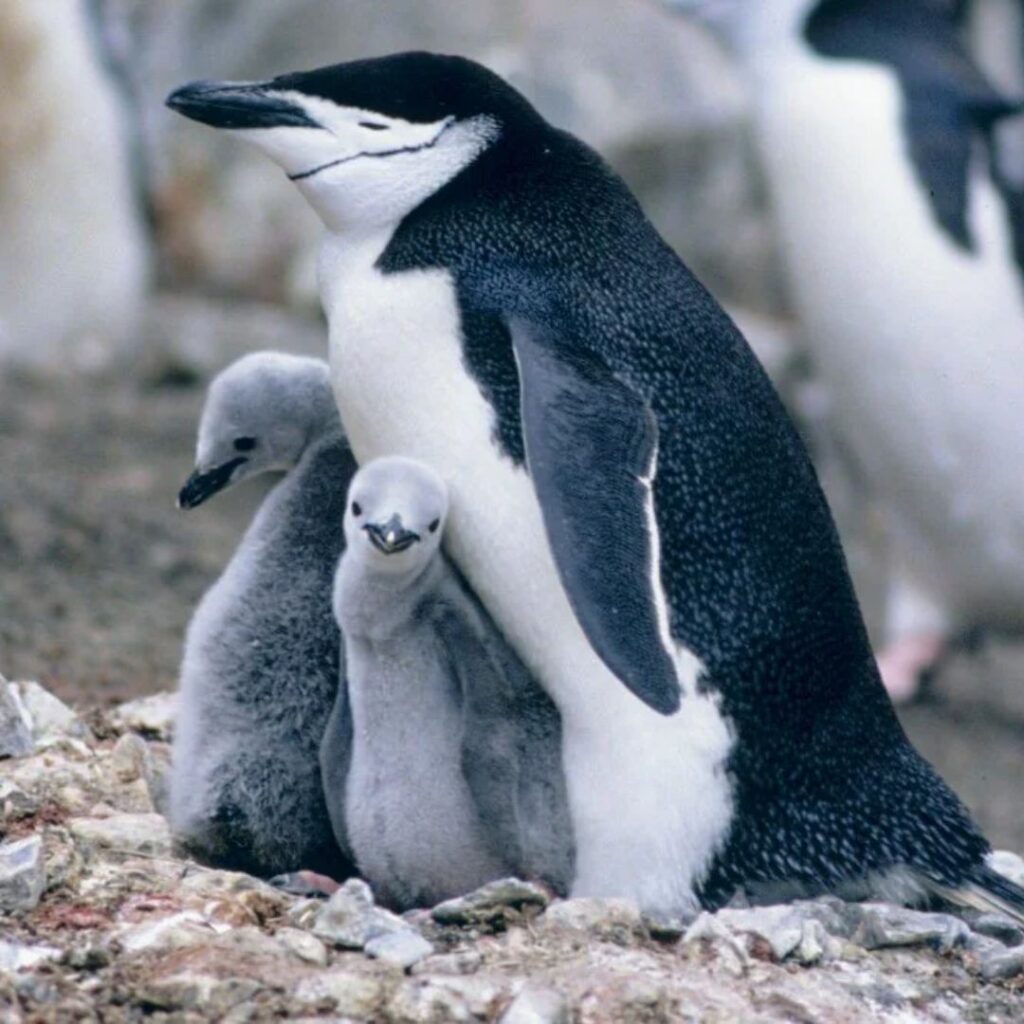
Chinstrap penguins, with their distinctive facial markings and charming personalities, captivate animal lovers worldwide. These Antarctic birds offer a fascinating glimpse into the diverse world of penguins. Let’s dive into everything you need to know about these remarkable creatures, from their appearance and behavior to their habitat and conservation status.
[Fun Fact: The scientific name of chinstrap penguin is “Pygoscelis antarctica”]
Chinstrap Penguin Appearance
Chinstrap penguins stand out among their penguin cousins thanks to their unique facial feature. A narrow black band runs under their chin, resembling a helmet strap, which gives them their name. This distinctive marking makes them easy to identify, even from a distance.

These medium-sized penguins typically reach heights of 27 to 30 inches (68 to 76 cm) and weigh between 7 to 13 pounds (3 to 6 kg). Like most penguin species, they sport a classic tuxedo-like appearance with black backs and white fronts. Their flippers are black on the outer side and white underneath, perfectly adapted for swimming.
Chinstraps have a small, black bill and striking red eyes that contrast beautifully with their black and white plumage. Their pink feet complete their unique look, adding a splash of color to their otherwise monochromatic appearance.
Also Read: 8 Interesting Facts About Chinstrap Penguins
Chinstrap Penguin Habitat
Chinstrap penguins call the Antarctic Peninsula and several sub-Antarctic islands home. You’ll find them on the South Sandwich Islands, South Orkney Islands, South Shetland Islands, and even as far north as South Georgia. These birds prefer rocky, ice-free areas for nesting, often choosing steep slopes that offer protection from flooding and land-based predators.

During the breeding season, chinstraps gather in enormous colonies, some numbering in the millions. The largest known colony exists on Zavodovski Island, hosting an estimated 2 million individuals. These massive gatherings create a spectacular sight and sound, with the air filled with the penguins’ distinctive calls.
Chinstrap Penguin Adaptation
The Chinstrap Penguin has physiological and behavioral adaptations for surviving in the harsh Antarctic climate. Its streamlined body and wings adapted for flying underwater help with highly efficient swimming. Dense feathers trap a layer of insulating air and repel water, keeping them warm without overheating on land. Bold black and white camouflage markings allow them to blend into the ocean yet be visible to one another. Vivacious colonies act as protection in numbers from predators upon their frigid coastlines and pack ice.
Chinstrap Penguin Predators
The main predators of Chinstrap Penguins are seabirds and seals. Skuas and giant petrels are foremost threats to chicks and eggs, often attacking in large flocks to overwhelm parental defenses. Leopard seals pose considerable danger to all age groups of penguins, as they are powerful swimmers with no qualms about eating such agile prey. Killer whales also hunt Chinstrap Penguins on occasion, however, the colony behavior offers some safety in numbers from these formidable marine predators.

Chinstrap Penguin Diet
Chinstrap penguins primarily feed on krill, which makes up about 96% of their diet. They also enjoy small fish and squid when available. These skilled hunters excel in the water, capable of diving to depths of 230 feet (70 meters) in search of food.
Their streamlined bodies and powerful flippers allow chinstraps to swim at impressive speeds, reaching up to 20 miles per hour. This makes them one of the fastest penguin species, an adaptation that serves them well when chasing prey or escaping predators like leopard seals and killer whales.
Chinstrap Penguin Breeding
The breeding season for chinstrap penguins typically begins in November. Pairs often mate for life and return to the same nesting site year after year. They build nests using small stones, creating a simple circular structure to protect their eggs from the elements.

Females usually lay two eggs, which both parents take turns incubating for about 37 days. Once the chicks hatch, they stay in the nest for about a month, relying on their parents for food and protection. At around two months old, the young penguins molt their downy feathers and develop their waterproof plumage, preparing them for life at sea.
Chinstrap penguins reach sexual maturity at around 3 to 4 years old. In the wild, they can live up to 20 years, although the average lifespan is typically shorter due to various environmental challenges and predation.
Chinstrap Penguin Behavior
Known for their noisy nature, chinstrap penguins earned the nickname “stone cracker penguins” due to their loud, harsh calls. During breeding season, colonies become incredibly vocal as pairs communicate with each other and defend their territories.

These penguins show remarkable climbing abilities despite their awkward waddle on land. They navigate steep, rocky slopes with surprising agility, a skill that helps them reach safer nesting spots away from flooding and land-based predators.
Chinstraps are social birds, living in large colonies during the breeding season. These gatherings offer protection from predators and create a vibrant community atmosphere. Outside of the breeding season, they spend much of their time at sea, sometimes traveling up to 600 miles away from their nesting sites in search of food.
Facts about Chinstrap Penguin
1. Chinstrap penguins can leap up to 3 feet (0.9 meters) out of the water when swimming at full speed, a technique called “porpoising” that helps them breathe and avoid predators.

2. During the breeding season, chinstrap penguins may make up to 14 foraging trips per day to feed their chicks.
3. These penguins are known for their feisty temperament and will vigorously defend their nesting territories from intruders.
4. Chinstraps undergo a complete molt once a year, replacing all their feathers over a period of about two weeks.
5. Some chinstrap penguins have been observed engaging in same-sex pairing and successfully raising adopted eggs.
Also Read: Where Does the Gentoo Penguin Live?

Conclusion
Chinstrap penguins, with their distinctive appearance and fascinating behaviors, offer a captivating glimpse into the diverse world of Antarctic wildlife. From their impressive swimming abilities to their massive breeding colonies, these birds continue to intrigue scientists and nature enthusiasts alike.
As we face the challenges of a changing climate, understanding and protecting species like the chinstrap penguin becomes increasingly important. By learning about these remarkable birds, we gain a deeper appreciation for the intricate ecosystems of Earth’s polar regions and the need to preserve them for future generations.
Pingback: How Many African Penguins Are Left in 2024?